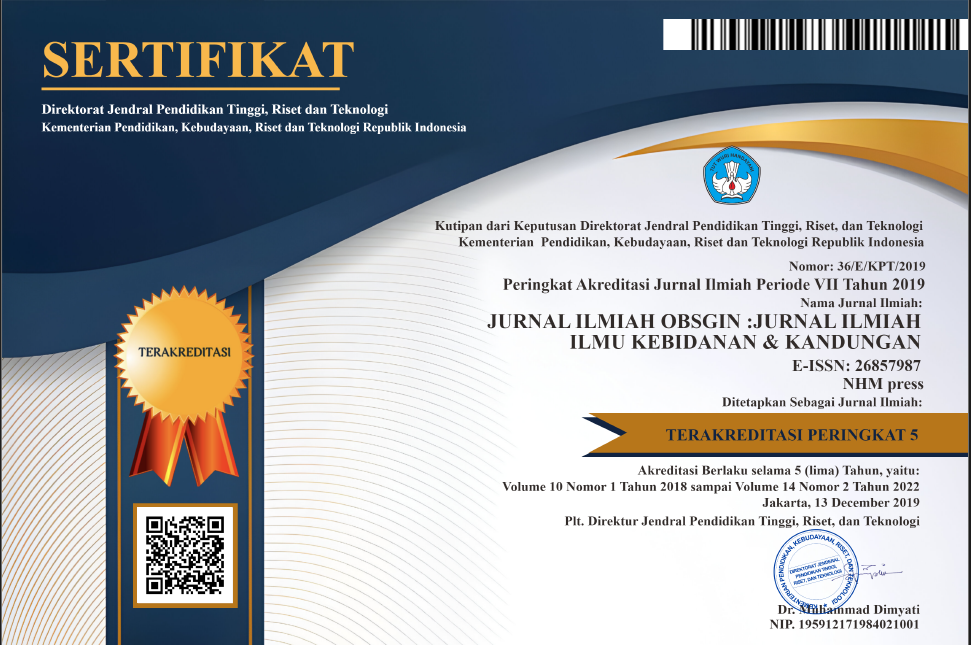Dampak Stunting Terhadap Kesehatan Anak: Narrative Review
Abstract
Stunting in children is a global public health problem that has a significant impact on physical, cognitive and social development. This research analyzed ten studies that examined the relationship between stunting and various aspects of child development, including cognition, motor skills and behavior. The research methods used varied, including cohort studies, case-control studies, and cross-sectional designs, with populations consisting of children under seven years of age in various countries. The results showed that children who were stunted had lower cognitive and motor scores compared to non-stunting children. Additionally, environmental factors, such as maternal education and perinatal conditions, contribute significantly to developmental outcomes. This research emphasizes the need for integrated early intervention to prevent stunting and support children's optimal development. Although this study provides important insights, limitations in design, sample size, and unmeasured variables must be noted. These findings underscore the importance of policies that support child nutrition and health to improve long-term well-being
References
Adjei-Mantey, K., & Takeuchi, K. (2021). The effect of in utero exposure to household air pollution on child health: Evidence from Ghana. Health Policy OPEN, 2, 100029. https://doi.org/https://doi.org/10.1016/j.hpopen.2020.100029
Adrizain, R., Faridah, L., Fauziah, N., Berbudi, A., Afifah, D. N., Setiabudi, D., & Setiabudiawan, B. (2024). Factors influencing stunted growth in children: A study in Bandung regency focusing on a deworming program. Parasite Epidemiology and Control, 26, e00361. https://doi.org/https://doi.org/10.1016/j.parepi.2024.e00361
Afaya, A., Afaya, R. A., Azongo, T. B., Yakong, V. N., Konlan, K. D., Agbinku, E., Agyabeng-Fandoh, E., Akokre, R., Karim, J. F., Salia, S. M., Kaba, R. A., & Ayanore, M. A. (2021). Maternal risk factors and neonatal outcomes associated with low birth weight in a secondary referral hospital in Ghana. Heliyon, 7(5), e06962. https://doi.org/https://doi.org/10.1016/j.heliyon.2021.e06962
Aheto, J. M. K., & Dagne, G. A. (2021). Geostatistical analysis, web-based mapping, and environmental determinants of under-5 stunting: evidence from the 2014 Ghana Demographic and Health Survey. The Lancet Planetary Health, 5(6), e347–e355. https://doi.org/https://doi.org/10.1016/S2542-5196(21)00080-2
Akerele, D., Fadare, O., Ogunniyi, A., Adeyemi, O., & Rufai, M. (2024). Effects of food price changes on child undernutrition among agricultural households in Nigeria. World Development Sustainability, 4, 100158. https://doi.org/https://doi.org/10.1016/j.wds.2024.100158
Akseer, N., Bhatti, Z., Mashal, T., Soofi, S., Moineddin, R., Black, R. E., & Bhutta, Z. A. (2018). Geospatial inequalities and determinants of nutritional status among women and children in Afghanistan: an observational study. The Lancet Global Health, 6(4), e447–e459. https://doi.org/https://doi.org/10.1016/S2214-109X(18)30025-1
Akseer, N., Kandru, G., Keats, E. C., & Bhutta, Z. A. (2020). COVID-19 pandemic and mitigation strategies: implications for maternal and child health and nutrition. The American Journal of Clinical Nutrition, 112(2), 251–256.
Akseer, N., Tasic, H., Nnachebe Onah, M., Wigle, J., Rajakumar, R., Sanchez-Hernandez, D., Akuoku, J., Black, R. E., Horta, B. L., Nwuneli, N., Shine, R., Wazny, K., Japra, N., Shekar, M., & Hoddinott, J. (2022). Economic costs of childhood stunting to the private sector in low- and middle-income countries. EClinicalMedicine, 45, 101320. https://doi.org/https://doi.org/10.1016/j.eclinm.2022.101320
Alam, M. A., Richard, S. A., Fahim, S. M., Mahfuz, M., Nahar, B., Das, S., Shrestha, B., Koshy, B., Mduma, E., & Seidman, J. C. (2020). Impact of early-onset persistent stunting on cognitive development at 5 years of age: Results from a multi-country cohort study. PloS One, 15(1), e0227839.
Ali, M. S., Kassahun, C. W., Wubneh, C. A., Mekonen, E. G., & Workneh, B. S. (2022). Determinants of undernutrition among private and public primary school children: A comparative cross-sectional study toward nutritional transition in northwest Ethiopia. Nutrition, 96, 111575. https://doi.org/https://doi.org/10.1016/j.nut.2021.111575
Alm, S., Stoltz Sjöström, E., & Domellöf, M. (2023). Prevalence and Risk Factors for Post-Discharge Feeding Problems in Children Born Extremely Preterm. Journal of Pediatric Gastroenterology and Nutrition, 76(4), 498–504. https://doi.org/https://doi.org/10.1097/MPG.0000000000003704
Asefa, A., Girma, D., Kaso, A. W., Ferede, A., Agero, G., & Beyen, T. K. (2024). Prevalence of stunting and associated factors among under-five children in Robe Woreda, Arsi zone, Ethiopia. International Journal of Africa Nursing Sciences, 21, 100782. https://doi.org/https://doi.org/10.1016/j.ijans.2024.100782
Aurora, W. I. D., Darmawan, A., Kusdiyah, E., & Nuriyah, N. (2024). Evaluation Of Growth And Development Of Stunting Childrens: A Case Control Study. Jambi Medical Journal: Jurnal Kedokteran Dan Kesehatan, 12(1), 16–23.
Casale, D., Desmond, C., & Richter, L. (2014). The association between stunting and psychosocial development among preschool children: a study using the S outh A frican B irth to T wenty cohort data. Child: Care, Health and Development, 40(6), 900–910.
Chang, S. M., Walker, S. P., Grantham‐McGregor, S., & Powell, C. A. (2002). Early childhood stunting and later behaviour and school achievement. Journal of Child Psychology and Psychiatry, 43(6), 775–783.
Crookston, B. T., Dearden, K. A., Alder, S. C., Porucznik, C. A., Stanford, J. B., Merrill, R. M., Dickerson, T. T., & Penny, M. E. (2011). Impact of early and concurrent stunting on cognition. Maternal & Child Nutrition, 7(4), 397–409.
Ekholuenetale, M., Barrow, A., Ekholuenetale, C. E., & Tudeme, G. (2020). Impact of stunting on early childhood cognitive development in Benin: evidence from Demographic and Health Survey. Egyptian Pediatric Association Gazette, 68, 1–11.
Geere, J.-A. L., & Hunter, P. R. (2020). The association of water carriage, water supply and sanitation usage with maternal and child health. A combined analysis of 49 Multiple Indicator Cluster Surveys from 41 countries. International Journal of Hygiene and Environmental Health, 223(1), 238–247. https://doi.org/https://doi.org/10.1016/j.ijheh.2019.08.007
Ghosh, K., Chakraborty, A. S., & Mog, M. (2021). Prevalence of diarrhoea among under five children in India and its contextual determinants: A geo-spatial analysis. Clinical Epidemiology and Global Health, 12, 100813. https://doi.org/https://doi.org/10.1016/j.cegh.2021.100813
Gilano, G., Dekker, A., & Fijten, R. (2024). Effect of mobile phone messaging on uptake of maternal and child health service in southern Ethiopia: Protocol for cluster randomized controlled trial. Clinical Nutrition Open Science, 54, 89–99. https://doi.org/https://doi.org/10.1016/j.nutos.2024.02.002
Haile, B., & Headey, D. (2023). Growth in milk consumption and reductions in child stunting: Historical evidence from cross-country panel data. Food Policy, 118, 102485.
Klein, L. J., Abdullahi, S. U., Gambo, S., Stallings, V. A., Acra, S., Rodeghier, M., & DeBaun, M. R. (2023). Risk factors in underweight older children with sickle cell anemia: a comparison of low- to high-income countries. Blood Advances, 7(22), 6923–6930. https://doi.org/https://doi.org/10.1182/bloodadvances.2023009711
Li, Y., Wei, Q., Meng, D., Pan, X., Mo, Y., Yao, L., Jing, L., Zhao, D., Shen, K., & Xu, J. (2018). Treatment outcomes and associated factors among extremely preterm infants in a major children hospital in Guangxi, China. Pediatrics & Neonatology, 59(3), 263–266. https://doi.org/https://doi.org/10.1016/j.pedneo.2017.09.008
Mustakim, M. R. D., Irawan, R., Irmawati, M., & Setyoboedi, B. (2022). Impact of Stunting on Development of Children between 1-3 Years of Age. Ethiopian Journal of Health Sciences, 32(3).
Pranoto, N. W., Fauziah, V., Muchlis, A. F., Komaini, A., Rayendra, R., Susanto, N., Fitriady, G., Setyawan, H., Pavlovic, R., & Sibomana, A. (2024). Exploration of children’S motor skills with stunting vs. Non-stunting. Retos: Nuevas Tendencias En Educación Física, Deporte y Recreación, 54, 224–234.
Tang, X., Zhao, Y., Liu, Q., Hu, D., Li, G., Sun, J., & Song, G. (2022). The Effect of Risk Accumulation on Childhood Stunting: A Matched Case-Control Study in China. Frontiers in Pediatrics, 10, 816870.
Woldehanna, T., Behrman, J. R., & Araya, M. W. (2017). The effect of early childhood stunting on children’s cognitive achievements: Evidence from young lives Ethiopia. Ethiopian Journal of Health Development, 31(2), 75–84.
World Health Organization, U. N. C. F., & Bank, W. (2021). Levels and trends in child malnutrition: UNICEF / WHO / The World Bank Group joint child malnutrition estimates: key findings of the 2021 edition. World Health Organization. https://iris.who.int/handle/10665/341135











